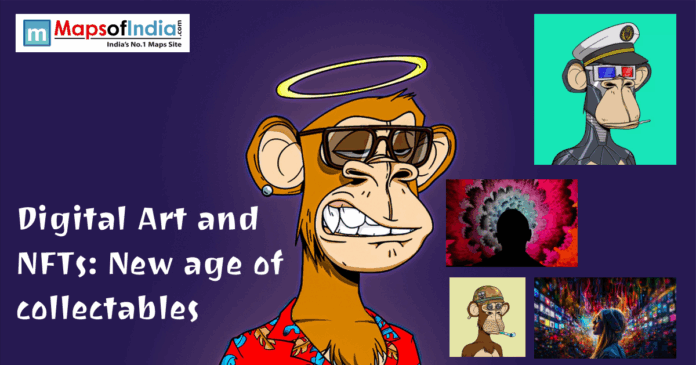The world of art is changing drastically with the rise of digital art and NFTs. The art format, which was once limited to galleries and mostly focused on physical media, with the rise of the digital age, has expanded into the digital space. Artists, collectors, and investors are now interacting in new ways that redefine what we know about ownership, creativity, and value. The rise of NFTs or non-fungible tokens has created a new marketplace that has changed the known traditional views of collectables. The rise of this new age of collectables has shifted the representation not only of technological progress but also of cultural change in how people view art.
What is Digital Art
To begin, what is called digital art refers to the artwork that has been created or displayed using digital technology. This art can include various art formats like illustrations, animations, photography, and 3D models. There are differences from the known traditional art format. The digital works exist in electronic formats. This digital art can be shared, duplicated, and displayed on any device. Using digital tools gives artists the freedom to experiment with new artistic styles and techniques of creating art. In recent years, that format of digital art has gained recognition in different industries like design, gaming, and media. But still, the digital arts’ value as a collectible item was unclear until the arrival of NFTs.
Understanding NFTs
Understanding what NFTs are is simple. To begin with, the NFTs stand for non-fungible tokens. These are digital assets which are stored using blockchain technology. Each NFT is different from the other; you can say they are unique and cannot be replaced or exchanged like we do with cryptocurrencies. These can give proof of ownership and authenticity for creators’ digital creations. Many artists, through the use of NFTs, sell a piece of digital art while still holding the records of its originality. When you buy the NFT, you own the token of that artwork that represents the artwork, even if copies exist online. Through this system, the world got introduced to the concept of scarcity and uniqueness to digital files, making them collectable.
The Link Between Digital Art and NFTs
The link that was established between digital art and NFTs has changed the art world. With the rise of these now have the ability to sell their work directly to collectors without having any middleman like galleries. NFTs can give the artist a secure method to establish ownership of their own art, which only existed in digital form. These also gave the confidence to the collector that their purchase is authentic and unique. The rise of this combination of creativity and technology has given rise to an entirely new art economy.
Why Collectors Value NFTs
Collectors are loving the NFTs because they can combine uniqueness with giving you verifiable ownership of the artwork. Owning an NFT is not just about having ownership of art itself, but at the same time, it gives you a sense of belonging to a new cultural movement. Limited editions and exclusivity of the artwork create scarcity. Owning an NFT most of the time comes with perks like access to events, collaborations, or a way to connect with digital communities. If you are a new collector, NFTs can be seen as investments that can increase in value over time. Some collectors value the social status that they gain, which comes with owning rare digital works.
How Artists Benefit from NFTs
Through the use of NFTs, artists can gain opportunities to break free from the traditional system, which was not that beneficial for them. With the use of NFTs, various artists can sell their artworks directly to global audiences without relying on different galleries to show their artwork. When artists make smart contracts on blockchain platforms, it allows the creators to earn royalties each time their work is resold. This can give artists the long-term income and recognition they deserve. NFTs also give a platform to the digital artists who were previously overlooked by galleries. For many artists, this is a new platform to experiment with art and build careers in ways that were not possible before.
The Role of Technology
The rise of technology has given rise to digital art and NFTs. The use of blockchain in this new way gives us the guarantee of transparency and security of art. The use of digital wallets and cryptocurrency made it easier to have transactions across the globe. The rise of tools like virtual reality and augmented reality has made the experience of art immersive. Through the use of various social media platforms, artists are promoting and showcasing NFT collections to large audiences. The combined use of these technologies creates an ecosystem where digital collectables can grow.
Criticisms and Challenges
Despite this new art format gaining immense popularity, NFTs face various criticisms and challenges. The environmental concerns are growing rapidly since some blockchains consume large amounts of energy to sustain themselves. This market volatility creates risks for both artists and collectors at the same time. There is also a concern about the issues of copyright and plagiarism, as various times the unauthorized works have been minted as NFTs on online sites. Access to these artworks is another challenge, since many art lovers do not understand how to use cryptocurrency and blockchain, and this is the necessary technical knowledge if you want to access them. These factors show us the need for sustainable and transparent solutions in this artistic industry.
Digital Art in the Metaverse
The use of the metaverse in digital art and NFTs has changed the art scenario we know today. Many people are using these digital platforms to display, trade, and experience art in different ways. Digital galleries and virtual exhibitions that are now famous all over the internet have made this art accessible to art lovers across the world. Collectors can now see the NFTs they own in 3D spaces or can use themself as avatars, fashion, and digital property.
NFTs Beyond Art
The influence of NFTs has gone beyond art. Many musicians are releasing their albums as NFTs, which can give fans ownership of their own chosen tracks. Various big sports teams sell NFT collectables of iconic moments. Fashion brands are making the most use of it to create a digital clothing experience for avatars in virtual spaces. In recent times the real estate industry has also entered the NFT market with tokenized property ownership. This expansion shows the versatility of NFTs as digital collectables across sectors.





